Cells can die in a number of different manners, depending on the cellular context and triggering stimulus.
Cell death mechanisms include:
Different assays can be used to determine the mechanism of cell death or rule out a mechanism of cell death within a cellular population.
Apoptosis is a highly regulated form of programmed cell death that occurs in multicellular organisms during development, throughout the lifespan, and in response to cellular stress. Apoptosis is mediated by a family of proteolytic enzymes called caspases. Other proteins, including proapoptotic and antiapoptotic proteins, also play important roles.
Dysregulation of apoptosis occurs in several disease states, including autoimmune disorders, neurodegenerative diseases, and cancer.
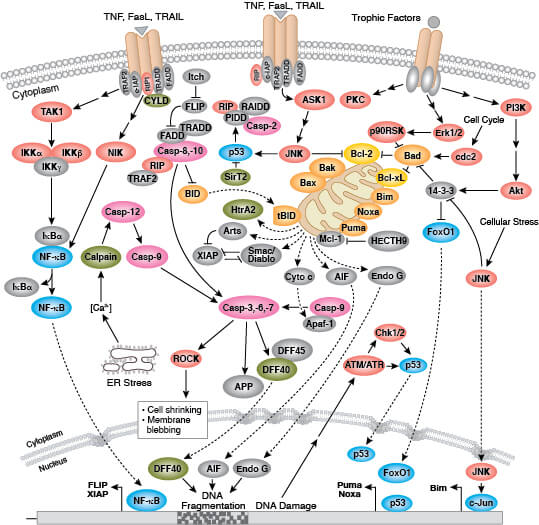
Apoptosis is a form of programmed cell death mediated by caspases and a host of other proteins.
Apoptotic cells can be distinguished from viable cells by phenotypic changes and activity of certain proteins. Several different methods can be used to analyze and measure levels of apoptosis within a population. These assays include:
| Assay | What is Measured | |
|---|---|---|
| Annexin V assay | Detects changes that occur to the lipid bilayer early in apoptosis | |
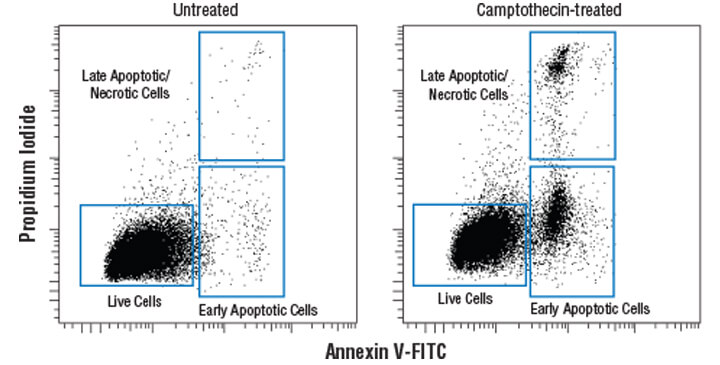
Annexin V-FITC Early Apoptosis Detection Kit #6592: Flow cytometric analysis of Jurkat cells untreated (left) or treated with camptothecin (10uM, 4 hr; right) using Annexin V-FITC Early Apoptosis Detection Kit. |
||
| TUNEL Kits | DNA fragmentation which is a hallmark of apoptosis | |
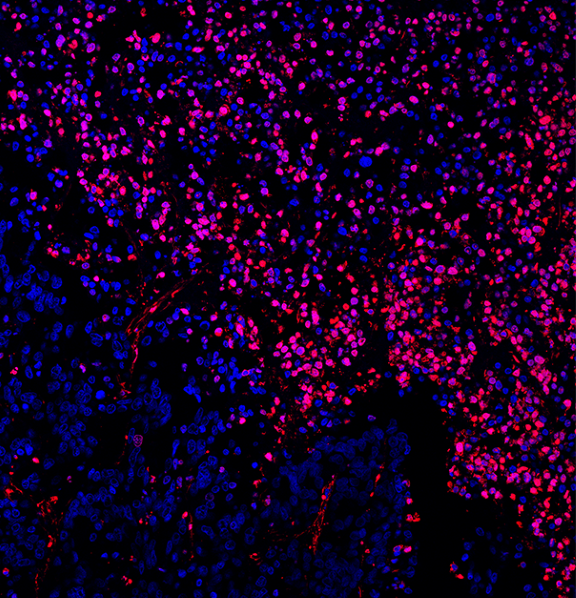
DNA fragmentation which is a hallmark of apoptosis |
||
| Caspase cleavage | Cleavage of caspase-3, caspase activity assay, and cleavage of other caspases and PARP are frequently used readouts for apoptosis | |
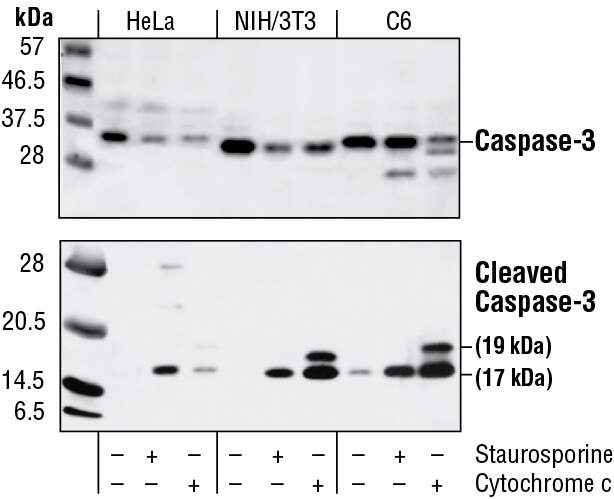
Cleaved Caspase-3 (Asp175) Antibody - #9661: Western blot analysis of extracts from HeLa, NIH/3T3 and C6 cells untreated, staurosporine-treated (3hrs, 1 μM in vivo) or cytochrome c-treated (1hr, 0.25 mg/ml in vitro), using Caspase-3 Antibody #9662 (upper) or Cleaved Caspase-3 (Asp175) Antibody (lower). |
||
| Chromatin condensation | Detects apoptotic cells with condensed chromatin after staining with nuclear dyes, such as DAPI or Hoechst 33342 | |
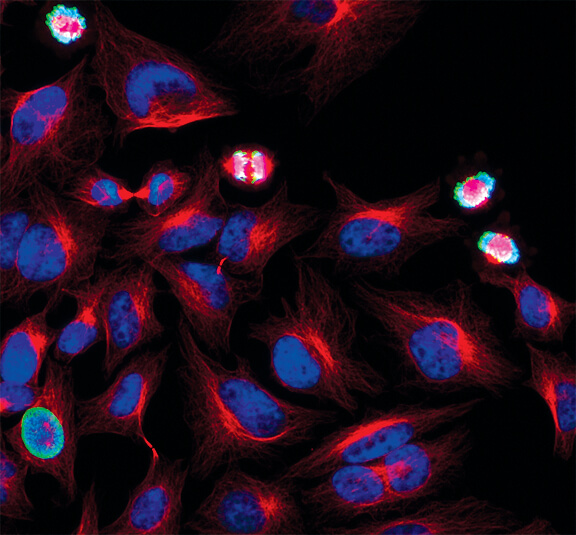
Hoechst 33342 #4082: Immunofluorescent analysis of HeLa cells using α-Tubulin (DM1A) Mouse mAb #3873 (red) and Phospho-Histone H3 (Ser10) (D2C8) XP® Rabbit mAb #3377 (green). Blue pseudocolor = Hoechst 33342 (fluorescent DNA dye). |
||
| Cytochrome c release | Translocation of cytochrome c from mitochondria to the cytoplasm is a hallmark feature of apoptotic cells | |
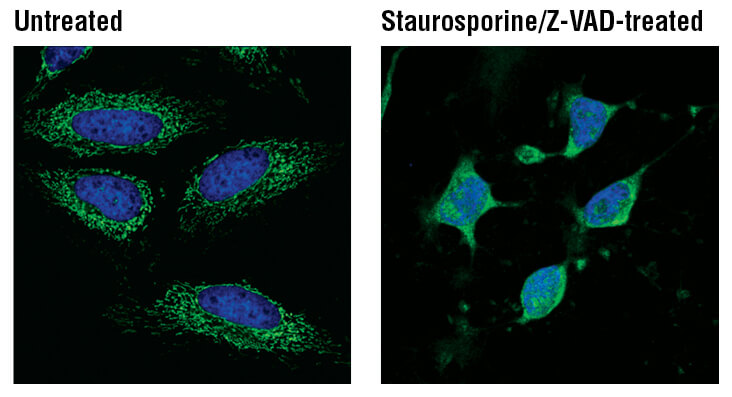
Cytochrome c (6H2.B4) Mouse mAb #129638: Confocal immunofluorescent analysis of HeLa cells, untreated (left) or treated with Staurosporine (1 μM) #9953 and Z-VAD (50 μM) for 3 hours (right), using Cytochrome c (6H2.B4) Mouse mAb (green). Blue pseudocolor= DRAQ5 #4084 (fluorescent DNA dye). |
||
| Mitochondrial membrane potential assay | Depolarization and subsequent decrease of the mitochondrial membrane potential is a hallmark feature of apoptotic cells | |
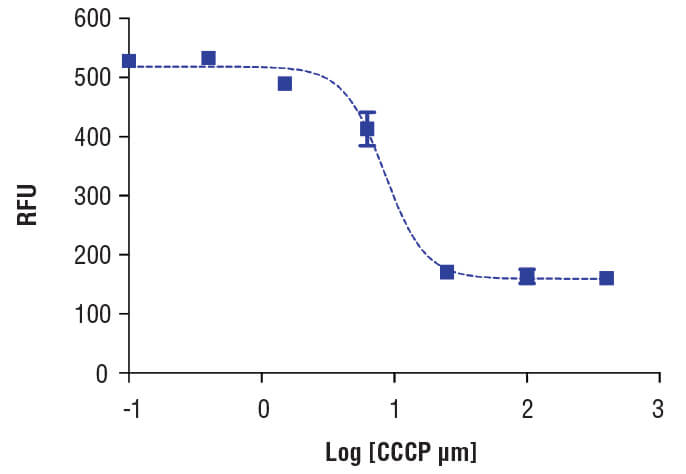
Mitochondrial Membrane Potential Assay Kit (II) #13296: HeLa cells (3x105 cell/ml) were treated with various concentrations of CCCP for 15 minutes prior to labeling with 200 nM TMRE. |
||
Necrosis has been classically defined as an unprogrammed cell death that occurs following acute injury or infection or when apoptosis is inhibited and is characterized by cellular swelling and lysis. Necrotic cells release intracellular contents into the surrounding environment, which activates an inflammatory response to recruit phagocytes to clear dead cells. Uncontrolled, however, necrosis can cause severe tissue damage, such as gangrene.
While it was previously thought that necrosis was passive and unprogrammed, recent data have uncovered different types of regulated necroptotic pathways.
In addition to necrosis, other lytic cell death mechanisms include:
| Necroptosis Marker | Necroptosis Marker Description | |
|---|---|---|
| RIP | Ser/Thr kinase that regulates inflammation and cell death | |
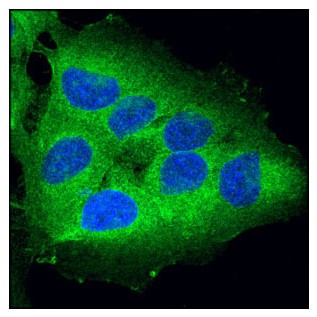
RIP (D94C12) XP® Rabbit mAb #3493: Confocal immunofluorescent analysis of OVCAR8 cells using RIP (D94C12) XP® Rabbit mAb (green). Blue pseudocolor = DRAQ5 #4084 (fluorescent DNA dye). |
||
| RIP3 | Ser/Thr kinase that is required for necroptosis | |
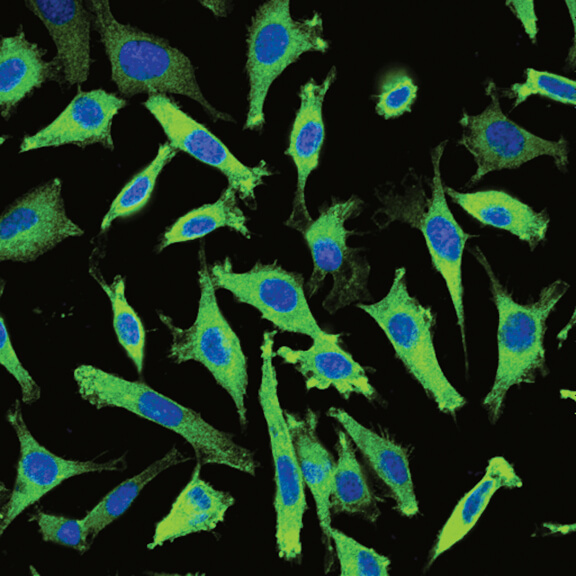
RIP3 (D4G2A) Rabbit mAb #95702: Confocal immunofluorescent analysis of L-929 using RIP3 (D4G2A) Rabbit mAb (green). Blue pseudocolor = DRAQ5 #4084 (fluorescent DNA dye). |
||
| Phospho-RIP | Activated RIP associates with RIP3 to trigger necroptosis | |
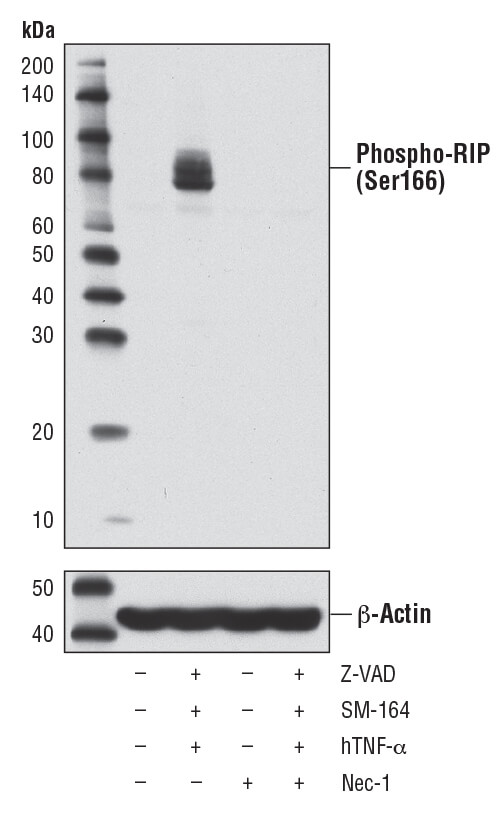
Phospho-RIP (Ser166) (D1L3S) Rabbit mAb #65746: Western blot analysis of HT-29 cells, untreated (-) or treated with combinations of the following treatments as indicated: Z-VAD (20 μM, added 30 min prior to other compounds; +), human TNF-α (hTNF-α, 20 ng/ml, 7 hr; +), SM-164 (100 nM, 7 hr; +), and necrostatin-1 (Nec-1, 50 μM, 7 hr; +), using Phospho-RIP (Ser166) (D1L3S) Rabbit mAb (upper) or β-Actin (D6A8) Rabbit mAb #8457 (lower). |
||
| Phospho-RIP3 | Activation of RIP3 leads to phosphorylation of MLKL | |
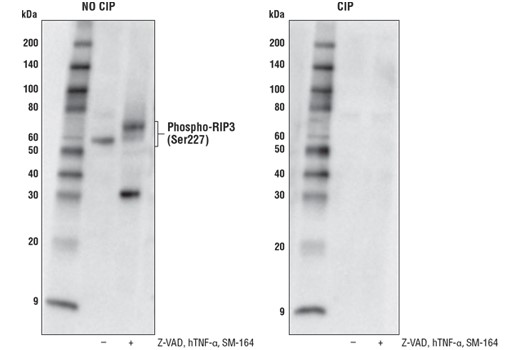
Phospho-RIP3 (Ser227) (D6W2T) Rabbit mAb #93654: Western blot analysis of HT-29 cells, untreated (-) or treated with a combination of the following treatments as indicated: Z-VAD (20 μM, added 30 min prior to other compounds; +), Human Tumor Necrosis Factor-α #8902 (hTNF-α, 20 ng/ml, 7 hr; +), and SM-164 (100 nM, 7 hr; +), using Phospho-RIP3 (Ser227) (D6W2T) Rabbit mAb. To confirm phospho-specificity, membranes were either untreated (left) or treated with Calf Intestinal Phosphatase (CIP; right). |
||
| MLKL | Downstream protein target of RIP3 | |
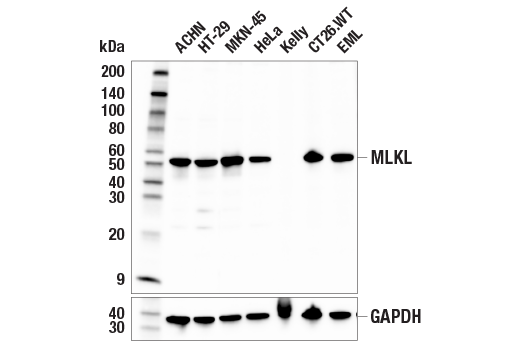
Western blot analysis of extracts from 293T cells, mock transfected (-) or transfected with a construct expressing Myc-tagged full-length human MLKL protein (hMLKL-Myc; +), using MLKL (E7V4W) Mouse mAb (upper) or GAPDH (D16H11) XP® Rabbit mAb #5174 (lower). |
||
| Phospho-MLKL | Phosphorylation of MLKL leads to pore formation and is a marker for necroptotic cells | |
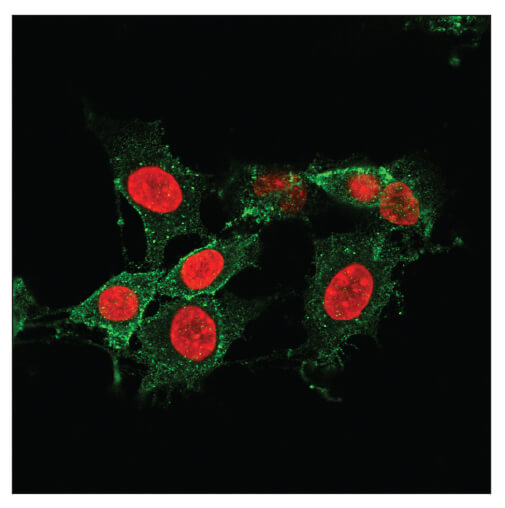
Phospho-MLKL (Ser345) (D6E3G) Rabbit mAb #37333: Confocal immunofluorescent analysis of L-929 cells, pre-treated with Z-VAD (20 μM, 30 min) followed by treatment with SM-164 (100 nM) and Mouse Tumor Necrosis Factor-α (mTNF-α) #5178 (20 ng/mL, 2.5 hr;) and then post-processed using Phospho-MLKL (Ser345) (D6E3G) Rabbit mAb (green). Red = Propidium Iodide (PI)/RNase Staining Solution #4087 (fluorescent DNA dye). |
||
| Pyroptosis Marker | Pyroptosis Marker Description | |
|---|---|---|
| Inflammasome formation | Pyroptosis is characterized by the formation of the inflammasome; a marker for the inflammasome is NLRP3 |  Inflammasome Signaling Interactive Pathway >> |
| Caspase-1 activity | Cleavage of caspase-1 is a marker for its activity. Activated caspase-1 cleaves IL-1β and gasdermin D | 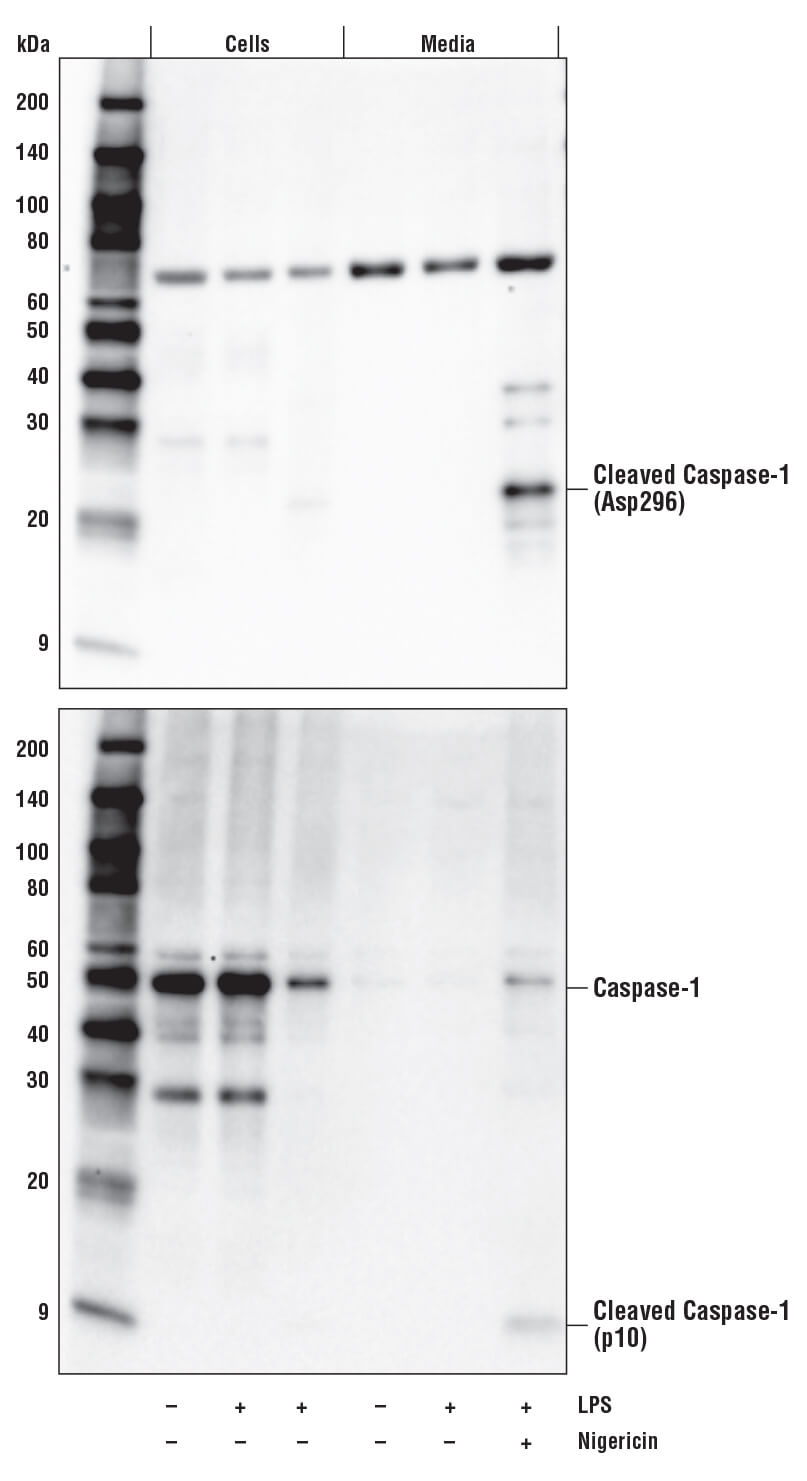
|
| Gasdermin cleavage | Cleavage of gasdermin-D occurs during pyroptosis lead to pore formation | 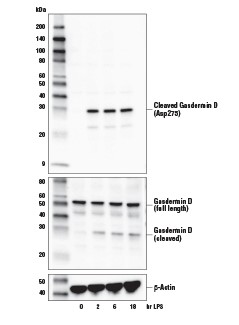
|
| Pyroptosis Marker | Pyroptosis Marker Description | |
|---|---|---|
| Inflammasome formation | Pyroptosis is characterized by the formation of the inflammasome; a marker for the inflammasome is NLRP3 | |

|
||
| Caspase-1 activity | Cleavage of caspase-1 is a marker for its activity. Activated caspase-1 cleaves IL-1β and gasdermin D | |

Cleaved Caspase-1 (Asp296) (E2G2I) Rabbit mAb #89332: Western blot analysis of cell extracts from the cells or media from mouse bone marrow derived macrophages (mBMDM), untreated (-) or treated with Lipopolysaccharides (LPS) #14011 (50 ng/ml, 4 hr) followed by Nigericin (15 μM, 45 min) (+), using Cleaved Caspase-1 (Asp296) (E2G2I) Rabbit mAb (upper), or Caspase-1 (E2Z1C) Rabbit mAb (lower). |
||
| Gasdermin cleavage | Cleavage of gasdermin-D occurs during pyroptosis lead to pore formation | |

Cleaved Gasdermin D (Asp275) (E7H9G) Rabbit mAb #36425: Immunohistochemical analysis of paraffin-embedded human ductal breast carcinoma using Cleaved Gasdermin D (Asp275) (E7H9G) Rabbit mAb. |
||
| Necrosis Marker | Necrosis Marker Description | |
|---|---|---|
| High mobility group protein B1 (HMGB1) | Nuclear protein that is released into the extracellular environment during necrotic, but not apoptotic, cell death | |
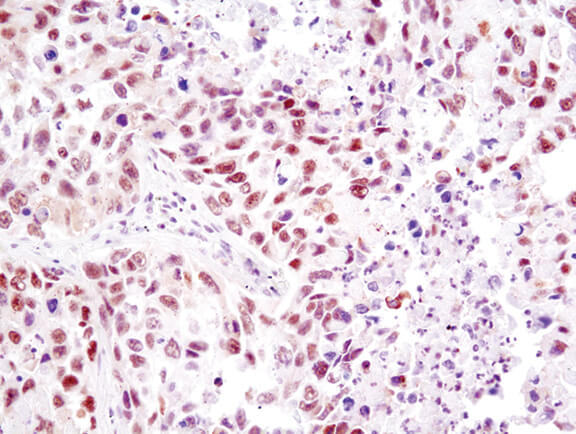
HMGB1 (D3E5) Rabbit mAb #6893: Western blot analysis of extracts from various cell lines using HMGB1 (D3E5) Rabbit mAb. |
||
| Lactate dehydrogenase A (LDHA) | Cytosolic enzyme released into the extracellular space during necrotic cell death | |
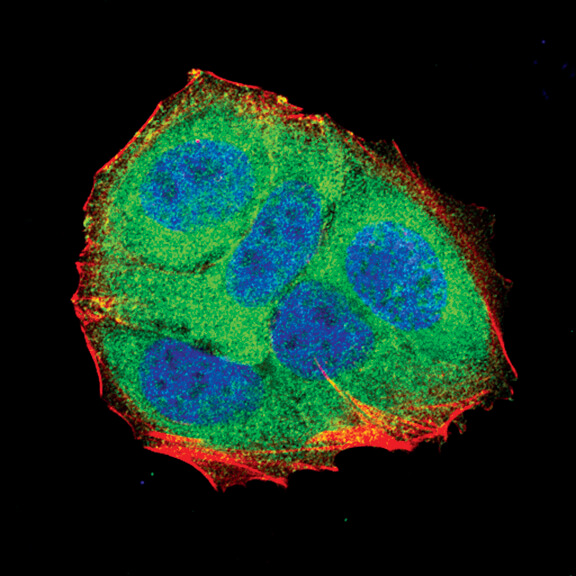
LDHA (C4B5) Rabbit mAb #3582: Western blot analysis of extracts from various cell types using LDHA (C4B5) Rabbit mAb. |
||
| Interleukin-1β (IL-1β) | Proinflammatory cytokine released during necrosis | |
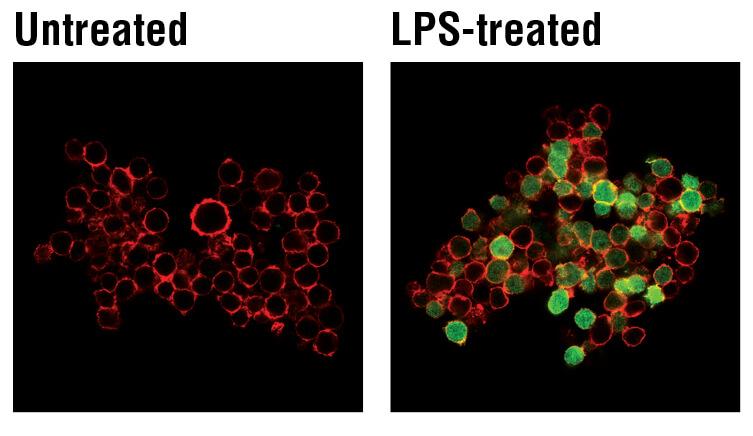
IL-1β (D3U3E) Rabbit mAb #12703: Confocal immunofluorescent analysis of THP-1 cells, untreated (left) or LPS-treated (500 ng/ml, 2 hr; right), using IL-1β (D3U3E) Rabbit mAb (green). Actin filaments were labeled with DY-554 phalloidin (red). |
||